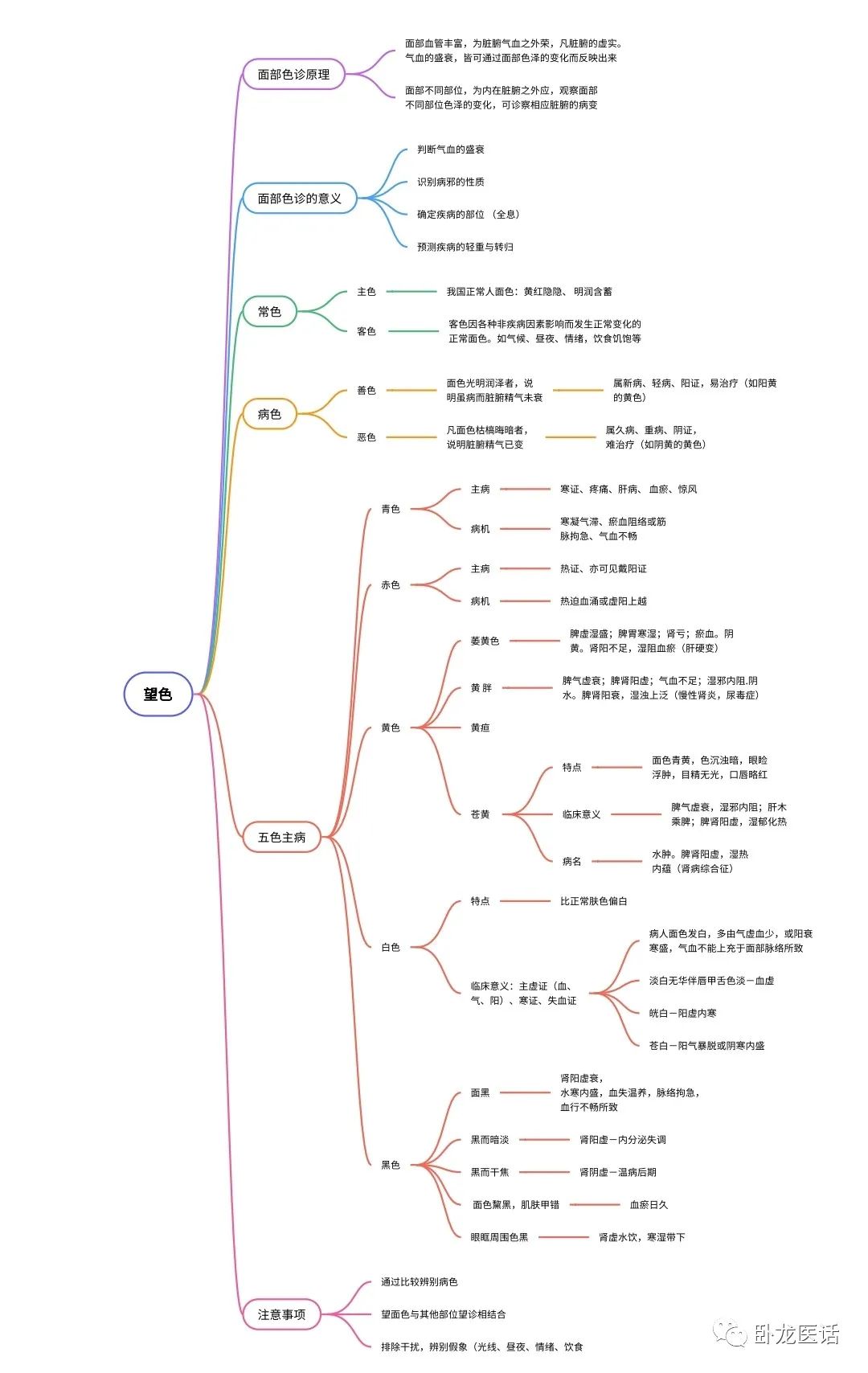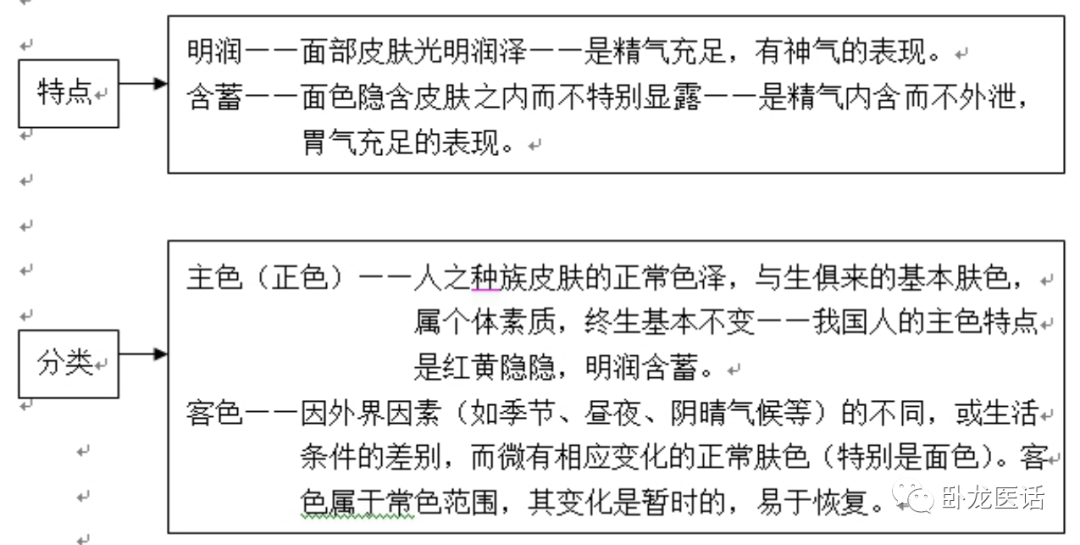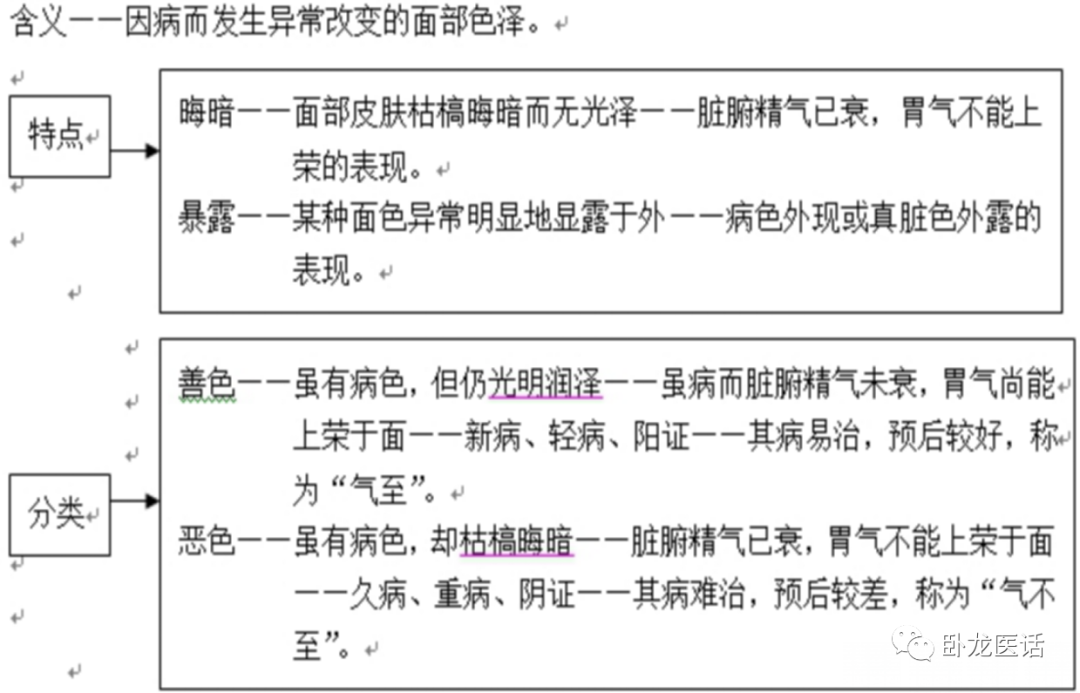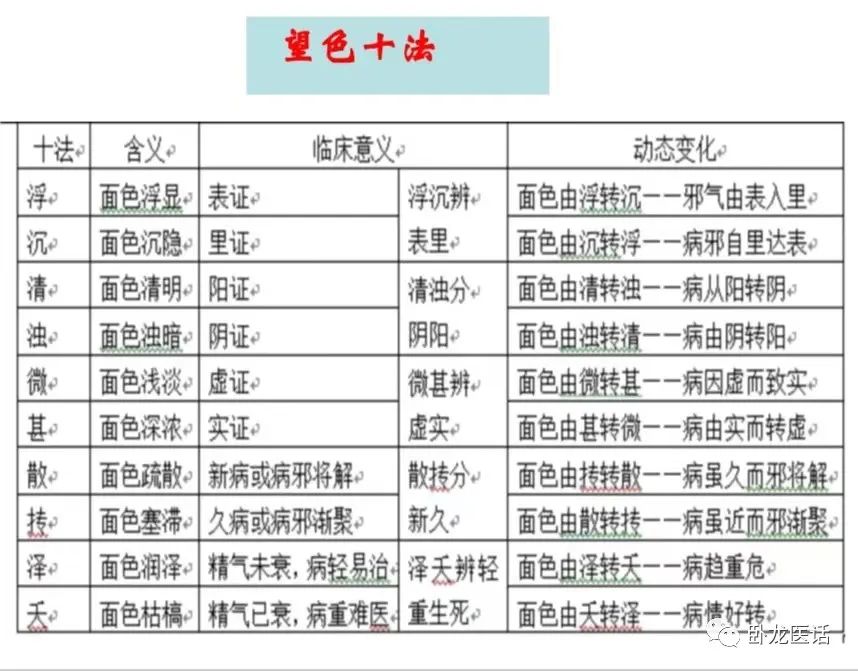Color Observation: Refers to the method of diagnosing a patient’s condition by observing the color and luster of the skin (mainly the face).


(1) Principles of Facial Color Diagnosis
• The face has abundant blood vessels, reflecting the qi and blood of the internal organs. The deficiency or excess of the internal organs can be reflected through changes in facial color. • Different areas of the face correspond to different internal organs; observing changes in color in these areas can help diagnose corresponding organ diseases. The significance of facial color diagnosis includes assessing the condition of qi and blood, identifying the nature of pathogens, determining the location of diseases (holistic), and predicting the severity and prognosis of diseases. • Good color – a bright and moist complexion, subtle and concealed. Although ill, the vital energy is not diminished, indicating a mild or new illness, and a yang condition. • Bad color – a dull and dry complexion indicates that the vital energy has deteriorated, suggesting a severe or chronic illness, and a yin condition.
(2) Normal and Pathological Colors
1. Normal Color – The facial color of a healthy person

(1) Main Color: The normal facial color of people in China is a subtle yellow-red, bright and moist. (2) Guest Color: The normal facial color that changes due to various non-disease factors, such as climate, time of day, emotions, and diet.
2. Pathological Color

(1) Good Color: A bright and moist complexion indicates that although ill, the internal organs’ vital energy has not diminished, suggesting a new or mild illness, and a yang condition, which is easier to treat (e.g., the yellow of yang jaundice). (2) Bad Color: A dull and dark complexion indicates that the internal organs’ vital energy has changed, suggesting a chronic or severe illness, and a yin condition, which is difficult to treat (e.g., the yellow of yin jaundice).
(3) The Five Colors and Their Associated Diseases
1. Green Color
Main Diseases: Cold conditions, pain, liver diseases, blood stasis, and convulsions.
Pathogenesis: Cold congeals and qi stagnates, blood stasis obstructs or muscles and tendons are tense, leading to poor circulation of qi and blood. Green indicates cold pain, liver stasis, and convulsions.
2. Red Color
Main Diseases: Heat conditions, also seen in yang conditions.
Pathogenesis: Heat forces blood to surge or virtual yang rises. A fully red face indicates real heat (accelerated blood flow, dilated vessels), while red cheeks indicate virtual heat (yin deficiency with yang excess, virtual fire rising). Red cheeks like makeup indicate a yang condition (true cold with false heat, yin excess counteracting yang).
Red heat, virtual and real yang conditions.
3. Yellow Color
Main Diseases: Spleen deficiency and dampness. (1) Withered Yellow: A dull yellow complexion, close to black, especially on the cheeks and chin, with pale yellow eyes and dark lips. Indicates spleen deficiency with excess dampness; cold dampness in the spleen and stomach; kidney deficiency; blood stasis. Yin yellow indicates kidney yang deficiency with dampness and blood stasis (e.g., liver cirrhosis). (2) Fat Yellow: A puffy and swollen face, with a muddy pale yellow color, black nose, and pale lips. Indicates spleen qi deficiency; kidney yang deficiency; insufficient qi and blood; internal dampness. Yin water indicates spleen and kidney yang deficiency with dampness rising (e.g., chronic nephritis, uremia). (3) Pale Yellow: A greenish-yellow complexion, dark and muddy color, with swollen eyelids, dull eyes, and slightly red lips. Clinical significance: Spleen qi deficiency with internal dampness; liver wood invading the spleen; spleen and kidney yang deficiency with dampness transforming into heat. Disease name: Edema. Spleen and kidney yang deficiency with internal heat (e.g., nephrotic syndrome).
Yellow indicates spleen deficiency and dampness.
4. White Color
Characteristics: Whiter than normal skin tone.
Clinical Significance: Indicates deficiency conditions (blood, qi, yang), cold conditions, and blood loss. • A patient with a pale complexion often has qi deficiency and blood loss, or yang deficiency with excess cold, leading to insufficient qi and blood filling the facial vessels. • Pale and dull complexion with pale lips and tongue indicates blood deficiency; • Ashy white indicates yang deficiency with internal cold; • Pale indicates yang qi collapse or internal excess cold. A pale complexion that is dull and muddy, with black around the forehead, eyes, and mouth, and dark red lips indicates blood loss; deficiency conditions; cold conditions; yang deficiency with excess cold, poor blood circulation leading to cough. Lung and kidney qi deficiency with excess cold (e.g., chronic bronchitis).
White indicates deficiency cold and qi-blood diseases.
5. Black Color • Indicates kidney deficiency, cold conditions, water retention, and blood stasis. • A patient with a black complexion often has kidney yang deficiency, excess cold water, and blood that has lost warmth and nourishment, leading to poor circulation. • Dull black indicates kidney yang deficiency and endocrine disorders; • Dry black indicates kidney yin deficiency and late-stage warm diseases; • A dark black complexion with skin and nails indicates long-term blood stasis; • Black around the eyes indicates kidney deficiency with water retention and cold dampness.
Black indicates kidney deficiency, cold, stasis, and sometimes pain invading internally.

Considerations for Facial Color Diagnosis: Compare and differentiate pathological colors; combine facial observation with observations of other body parts; eliminate interference and distinguish false appearances (light, time of day, emotions, diet).

Responsible Person: Cheng Zhengxin

